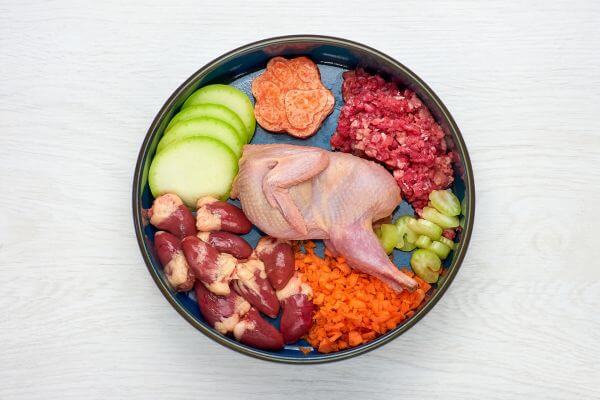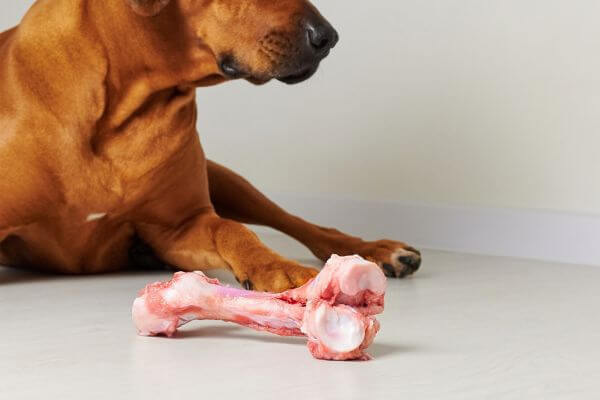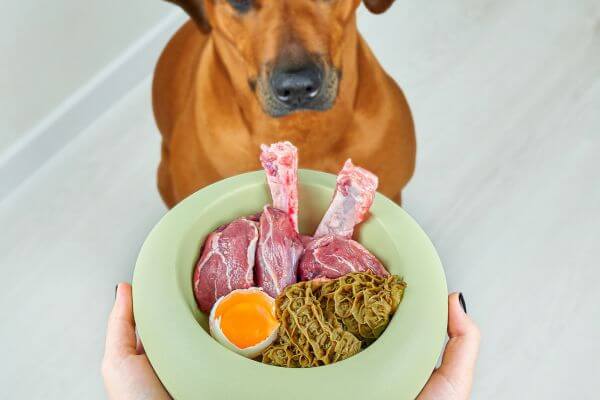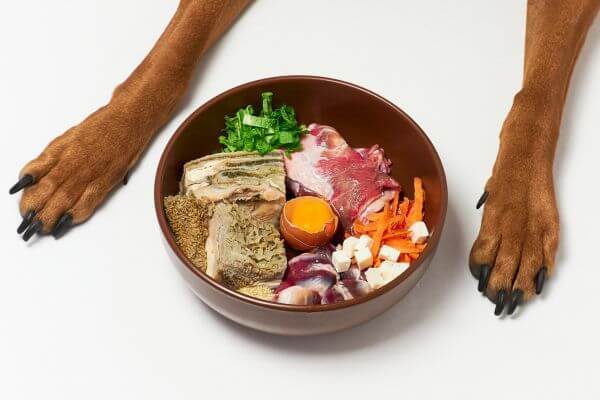In this article, we will explore the benefits of raw feeding for dogs, as well as some recommended recipes. If you’re a dog owner interested in providing a healthy and natural diet for your furry companion, this guide is for you!
Why Choose Raw Feeding?

Raw feeding, also known as BARF or ACBA, offers a range of health benefits for your dog. By opting for this diet, you’re choosing a natural and nutritious approach that can improve your pet’s health and vitality.
By adopting raw feeding, you’re providing your dog with a diet rich in fresh, unprocessed ingredients. This means they’ll be getting all the essential nutrients they need to thrive. Additionally, raw feeding can help promote healthy digestion and reduce the risk of food allergies.
Another important benefit of raw feeding is that it can help improve your dog’s dental health. By chewing on raw foods, your dog naturally cleans their teeth and strengthens their gums. This can help prevent plaque and tartar buildup, reducing the risk of dental problems in the future.
Furthermore, raw feeding can help increase your dog’s energy levels and promote a healthy weight. By providing a balanced, protein-rich diet, your dog will have the energy they need to stay active and playful. This can be especially beneficial for older dogs or those with weight issues.
Delicious Options for Your Dog
Now, let’s explore some simple and healthy recipes you can prepare for your dog. These options ensure a balanced and tasty diet for your four-legged friend.
One of the most popular recipes in the raw diet is a mix of ground meat with vegetables. Simply combine quality ground meat with a variety of vegetables, such as carrots, broccoli, and zucchini. This meal is rich in protein and fiber, providing your dog with all the nutrients they need.
Another delicious option is raw fish. Fish is an excellent source of omega-3 fatty acids, which are essential for your dog’s skin and coat health. You can serve the raw fish whole or in pieces, ensuring a nutritious and tasty meal for your pet.
Additionally, don’t forget about organ meats! Organs like liver and kidney are extremely nutritious and should be part of your dog’s diet. You can include them in your recipes in a balanced way, ensuring adequate intake of vitamins and minerals.
How to Get Started with Raw Feeding

If you’re thinking about transitioning to raw feeding for your dog, here are some additional tips to help you get started on this nutritious and healthy journey.
It’s important to transition gradually, mixing raw foods with your dog’s current diet. This allows their digestive system to adjust to the new foods and reduces the risk of gastrointestinal issues.
Additionally, always make sure to provide high-quality, fresh foods. Choose fresh meat and organic vegetables whenever possible, ensuring your dog gets the best nutrients in their diet.
Finally, don’t forget to consult your veterinarian before making any changes to your dog’s diet. They can provide personalized guidance based on your pet’s specific needs, ensuring a smooth and safe transition to raw feeding.
Health Benefits for Your Dog
By opting for raw feeding, you’re investing in your dog’s long-term health and well-being. This diet can help strengthen your pet’s immune system, reducing the risk of diseases and infections.
Furthermore, raw feeding can contribute to your dog’s skin and coat health. The nutrients present in fresh, unprocessed foods can help promote a shiny coat and healthy skin, reducing the risk of dermatological problems.
Another important benefit of raw feeding is the improvement in your dog’s digestive health. By offering a natural and balanced diet, you’re helping to promote a healthy gut flora and prevent problems such as diarrhea and constipation.
Healthy and Tasty Recipes
Try preparing a complete meal for your dog by combining minced raw meat with fresh vegetables. This combination offers a variety of essential nutrients for your pet’s health, ensuring a balanced and tasty diet.
Another delicious idea is a mix of fresh fruits and raw meat. Fruits like apple, pear, and watermelon are an excellent source of vitamins and antioxidants, while raw meat provides high-quality proteins. Your dog will love this refreshing and nutritious combination!
Finally, don’t forget about healthy treat options for your dog. You can prepare delicious homemade biscuits using natural ingredients like oats, banana, and peanut butter. These treats are a great way to reward your dog during training or just as an occasional treat.
Smooth Transition to Raw Feeding
To ensure a smooth transition to raw feeding, start by introducing small amounts of raw foods into your dog’s diet and gradually increase over time. This allows your dog’s digestive system to adjust to the new foods.
Additionally, make sure to offer a variety of raw foods to ensure your dog gets all the necessary nutrients. This includes meats, bones, vegetables, and even fruits in small quantities.
Finally, closely monitor your dog’s health throughout the transition process and make adjustments as needed with guidance from your veterinarian. With proper care and veterinary supervision, you can provide your dog with a healthy and balanced raw diet.
The Importance of Veterinary Supervision

We cannot emphasize enough the importance of regular veterinary check-ups when adopting raw feeding for your dog. A qualified veterinarian can offer specific guidance based on your dog’s individual needs and ensure they’re receiving all the necessary nutrients.
Additionally, the veterinarian can help monitor your dog’s health over time and make adjustments to the diet as needed. This is especially important as your dog ages or faces any specific health issues.
Don’t hesitate to reach out to your veterinarian if you have any questions or concerns about your dog’s diet. They’re there to help and can offer personalized advice to ensure your dog is getting the best nutrition possible.
Final Tips for a Smooth Transition
To ensure a smooth transition to raw feeding, start by introducing small portions of raw foods into your dog’s diet and gradually increase over time. This allows your dog’s digestive system to adapt to the new foods.
Additionally, be sure to offer a variety of raw foods to ensure your dog receives all the necessary nutrients. This includes meats, bones, vegetables, and even fruits in small quantities.
Finally, closely monitor your dog’s health throughout the transition process and make adjustments as needed with guidance from your veterinarian. With proper care and veterinary supervision, you can provide your dog with a healthy and balanced raw diet.
Common Myths About Raw Feeding
It’s important to address some common myths surrounding raw feeding for dogs. One of the most prevalent myths is the fear of bacterial contamination. However, when raw foods are handled and stored correctly, the risk of contamination is minimal.
Another myth is the belief that raw bones pose a danger to dogs. In fact, raw bones are a natural part of the canine diet and can be safely consumed when provided in the appropriate form and closely supervised.
Finally, some believe that raw feeding is too expensive or complicated to prepare. However, with a little planning and research, it’s possible to offer a balanced and affordable raw diet for your dog.
Final Considerations on Raw Feeding
In conclusion, raw feeding offers a range of benefits for your dog’s health and well-being. By opting for this natural and nutritious approach, you’re providing your pet with a diet that better aligns with their biological needs and dietary instincts.
However, it’s important
to remember that every dog is unique, and what works for one may not work for another. It’s essential to be mindful of your dog’s individual needs and adjust the diet as necessary with guidance from your veterinarian.
If you’re considering transitioning to raw feeding for your dog, don’t hesitate to seek additional information and consult your veterinarian. With proper care and veterinary supervision, you can provide your dog with a healthy and nutritious diet that promotes a long, happy, and healthy life.
Delicious Recipes to Try Today

To get started, try preparing a simple meal of minced raw meat with fresh vegetables for your dog. This is an easy-to-make and highly nutritious option that your four-legged friend is sure to enjoy.
Another idea is to offer your dog a refreshing and healthy treat, such as cucumber or carrot slices. These options are great for hot days and provide an additional source of hydration for your dog.
Additionally, don’t forget about homemade treats! You can prepare oat and banana biscuits or ice cubes with fruit pieces for your dog. These options are delicious and easy to make at home.
The Importance of Veterinary Monitoring
We cannot emphasize enough the importance of maintaining regular communication with your veterinarian throughout the raw feeding transition process. They can provide specific guidance based on your dog’s age, breed, and overall health, ensuring they receive a balanced and nutritious diet.
Furthermore, your veterinarian can help monitor your dog’s health over time and make adjustments to the diet as needed. They may perform blood tests and regular health assessments to ensure your dog is receiving all the necessary nutrients to thrive.
Don’t underestimate the importance of veterinary supervision when adopting raw feeding for your dog. Work closely with your veterinarian to ensure you’re making the best dietary choices for your furry companion.
Common Myths About Raw Feeding
It’s important to address some common misconceptions about raw feeding for dogs. One prevalent myth is the concern about bacterial contamination. However, when handled and stored correctly, raw food is generally safe for dogs to consume.
Another myth is the belief that raw bones are hazardous for dogs. In reality, raw bones can be a beneficial part of a dog’s diet, as they provide essential nutrients and promote dental health when given in appropriate sizes and under supervision.
Lastly, some people believe that raw feeding is overly expensive or complicated. While it does require careful planning and consideration, with proper research and preparation, raw feeding can be an affordable and straightforward option for many dog owners.
Final Thoughts on Raw Feeding
In summary, raw feeding offers numerous benefits for dogs, including improved digestion, dental health, and overall well-being. However, it’s essential to approach raw feeding with careful consideration and guidance from a veterinarian.
Every dog is unique, and their dietary needs may vary. It’s crucial to monitor your dog’s health closely during the transition to raw feeding and make adjustments as needed under the supervision of a veterinarian.
By providing your dog with a balanced and nutritious raw diet, you can help them live a long, healthy, and happy life. Experiment with the delicious recipes recommended in this article and enjoy watching your dog thrive on a fresh and flavorful diet. Remember the importance of veterinary supervision and don’t hesitate to seek professional advice if you have any concerns about your dog’s diet.
Together, we can ensure our furry friends receive the best possible nutrition for a long, happy, and healthy life.